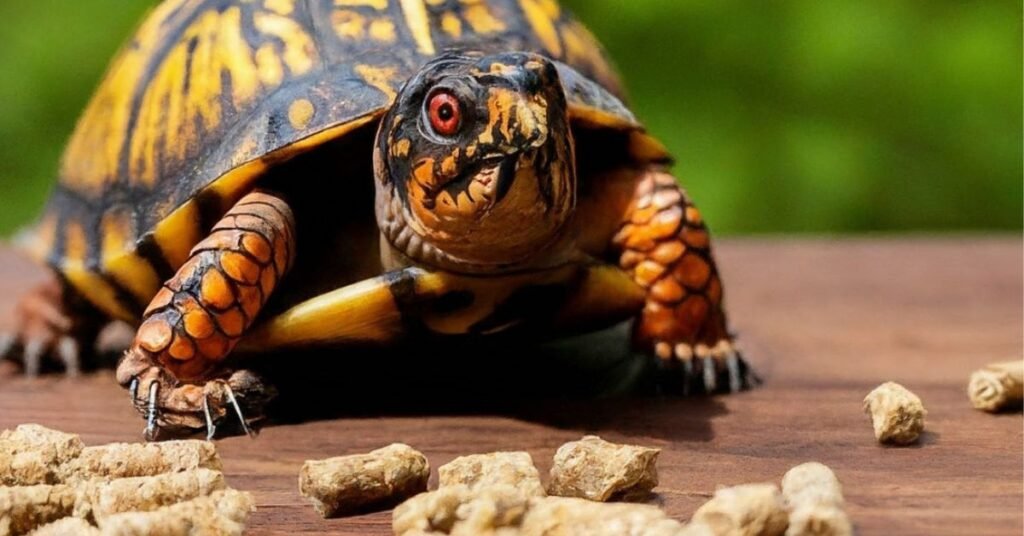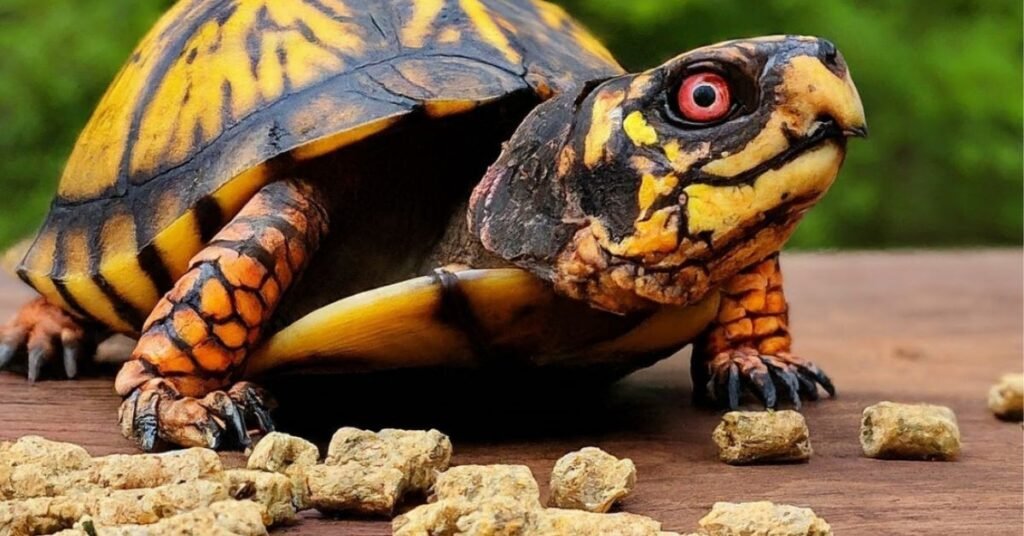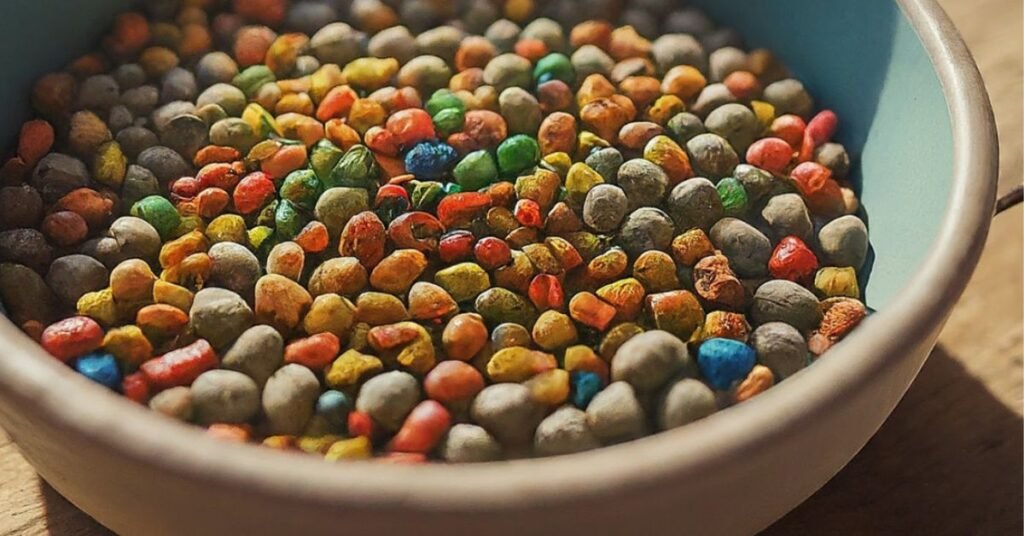Box turtles are one of the most popular turtle pets, with their attractive yellow-striped shell appearance. They are quite easy to handle and calm when it comes to turtle pet options. If you are an inexperienced box turtle pet owner, this is one of the most common questions you will encounter – what box turtles can eat? Well, box turtles are mainly omnivores.
As an omnivore turtle species, box turtles are primarily dependent on a diet of vegetables and protein. Feeding your box turtle the proper diet is vital to keeping them healthy and happy for years to come. Besides a regular diet, you have to include special turtle pellets as an easy and nutritious option. If your box turtle faces nutritional deficiency, a turtle palette can be the right way to go.
Table of Contents
What Box Turtles Can Eat?

Box turtles are omnivores, so they can eat both plant and meat-based food. Turtle pallets or supplements can be a great solution to overcome any health issue. Juvenile box turtles are carnivores that eat protein like crickets, worms, mealworms, fish, or cooked meat.
On the other hand, adult box turtles prefer vegetables and leafy green fruit. Their diet should include 50% protein, 30% vegetables, and 15-20% fruit.
Should You Introduce Turtle Pellets to Your Turtle?

Box turtles require a varied diet to thrive, consisting of fruits, vegetables, and proteins. However, there are times when fresh food might not be readily available. This is where special turtle pellets come into play. These pallets offer a convenient and nutritionally balanced option to ensure your turtle’s health and vitality.
Why Choose Turtle Pellets?
Turtle pellets are formulated to meet turtles’ dietary needs. They provide essential nutrients that might be missing from natural foods. These days, getting organic natural food has become challenging. Turtle pallets are especially useful when access to fresh fruits, vegetables, or proteins is limited.
Here, we have listed two favorite turtle palettes for your box turtles’ proper dietary needs.
Mazuri Fresh Water Turtle Diet
As a turtle owner, you probably understand the importance of a balanced diet for your shelled friend. Many fellow turtle enthusiasts rave about the Mazuri Fresh Water Turtle Diet. Mamzuri’s turtle pallet is a blend of nutrients that your turtle will need. Especially the high levels of Vitamin D3, which is crucial for calcium absorption, and Vitamin E, which is vital for a healthy shell and skin.
One of the best ingredients that many turtle owners love about this package is its 2:1 Calcium to Phosphorus ratio. It helps ensure your turtle develops strong bones without having too much protein. Whether your turtle leans towards a herbivorous or carnivorous diet, these pellets fit in perfectly.
ZooMed Natural Aquatic Turtle Pellets
If you chat with turtle owners, you’ll likely hear about ZooMed’s Natural Aquatic Turtle Pellets. This option is a go-to choice because it caters to turtles’ different life stages. For instance, Hatchling Formula is a big hit with young turtle owners due to its small size and high protein content.
The Maintenance Formula fits well with the dietary needs of herbivorous turtles with its lower protein content. In addition, turtle pet owners like ZooMed’s line because it avoids artificial additives. It feels good knowing you’re feeding your turtle something clean and wholesome!
What Nutritions Turtle Can Get From Pellets?
A turtle’s diet needs turtle pellets to get vital nutrients that their natural prey might not provide. Besides being high in protein, calcium, and vitamins, they’re also healthy. Here’s a quick breakdown of what to look for:
- Protein: Protein is essential for growth, especially for young turtles. Growth pellets are high in protein and calcium, ideal for baby turtles.
- Calcium is critical for box turtles’ shell and bone health. Look for pellets that balance calcium and phosphorus.
- Vitamins: Vitamins A, D3, and E are commonly included to support overall health.
- Variety: Turtles get the proper nutrition as they age through different pellets, like Fluker’s Tortoise Small Pellet Food, which caters to growth, maintenance, and maturity.
How To Introduce Turtle Pellets (Practical Tips)
If you introduce pellets, make sure they complement fresh food instead of replacing it. You can soak bigger pellets so they’re easier for small turtles to handle. For a balanced diet, include fresh fruits and vegetables along with pellets.
You should feed your box turtle turtle pellets when there are few fresh options. They are a reliable source of nutrition for your turtle’s health.
What Are The Benefits of Choosing Turtle Pellets?

Being a box turtle owner means you have to make sure your pet turtle is in good health. Sometimes, maintaining regular, balanced food with natural food can be challenging. You can simplify this task by using turtle pellets. The pellets are made specifically for your pet box turtles’ dietary needs, so they’re convenient and balanced.
Ease of Use and Convenience
Turtle pellets are incredibly user-friendly. Unlike preparing fresh meals, which can be time-consuming, pellets are ready to serve. They can be easily stored and have a long shelf life, which reduces the hassle of frequent grocery trips. This convenience ensures that your turtle’s feeding routine is consistent, which is crucial for their health. These pellets are available in bulk, and they offer a cost-saving option for those with multiple turtles.
Consistent Nutritional Content
One of the primary advantages of turtle pellets is their consistent nutritional content. These pellets are scientifically balanced to include the right amounts of protein, fats, and fibres. For instance, some high-quality pellets contain about 39% protein and 10% fat. This ratio is ideal for growing box turtles. This consistency also helps maintain their energy and supports their growth and development.
Formulated for Box Turtles
Turtle pellets are specially made to meet the dietary needs of box turtles. They often contain a mix of animal protein and plant matter, which reflects the turtles’ natural diet. In this formulation, they get the essential nutrients without the risk of an imbalanced diet.
What Should You Look Before Choosing The Right Turtle Pellet?
Most of the brands claim they are offering the best from their end. To some extent, this is true. But, before selecting the right turtle pellet, you have to look at some criteria:
Ingredient Quality
When selecting turtle pellets, prioritize those made with high-quality ingredients. Look for pellets made with natural components and avoid those with artificial colours or preservatives. High-quality ingredients ensure that your turtle receives the best possible nutrition.
Nutritional Content
Check the nutritional content of the pellets. A good pellet should have a balanced ratio of protein, fats, and fibers. Additionally, pellets enriched with essential vitamins and minerals like calcium and Vitamin D3 are beneficial. These nutrients are vital for promoting shell health and overall vitality.
Brand Reputation
Choose pellets from reputable brands known for their quality and reliability. Brands that are frequently recommended by zoos and veterinarians are often a safe choice. Reading reviews from other turtle owners can also provide insight into the effectiveness of the pellets.
Adding Variety
While turtle pellets can be a staple in your box turtle’s diet, it’s also essential to add variety. Although pellets can be a good option, we firmly recommend not being only dependent on these supplements. Supplementing pellets with fresh fruits, vegetables, and occasional animal proteins like worms can enrich their diet. This variety enhances their nutritional intake and keeps their meals interesting.
General Food Diet for Box Turtles
If you are looking for your box turtle diet, first, you have to focus on a general food diet. Box turtles need a variety of fruits and vegetables to stay healthy. Here, we have listed some essential general food diets for your pet box turtle.
Vegetables
Vegetables should include 30% of box turtles’ diet. For their vegetable diet, you can consider these options:
- Leafy Greens: Vegetables like kale and collard greens are packed with calcium, which is crucial for box turtles’ solid bones and shells.
- Carrots and Squash: Rich in vitamin A, these veggies support vision and immune health. Slice them thinly for easy consumption.
- Bell Peppers: Bell paper is high in vitamins C and A, which boost the immune system. Chop it into small pieces for your turtle.
- Variety is Key: Rotate different vegetables to cover a broad spectrum of nutrients, ensuring a balanced diet.
- Avoid Harmful Foods: Steer clear of avocado and rhubarb, as they can be toxic to turtles.
- Preparation Tips: Shred or chop vegetables to make them more digestible and appealing to your turtle.
Fruits
Fruit, a plant-based and sugary food, should be included in around 15-20% of turtles’ diets.
- Strawberries, Apples, and Melons: These fruits provide essential vitamins and hydration, which are necessary for box turtles’ overall health.
- Blueberries and Raspberries: These berries are packed with antioxidants, and they support immune function and cellular health.
- Grapes: Gapes can provide hydration and energy but serve them sparingly due to their high sugar content.
- Preparation Tips: Cut fruits into small, manageable pieces to ensure easy consumption and prevent your pet box turtle from choking.
- Serving Frequency: As a treat, you can add fruits to your box turtle’s diet about 10% of the time.
Proteins
Box turtles’ balanced diet heavily relies on proteins, which should make up 50% of their diet.
- Earthworms, Mealworms, and Snails: These are vital for muscle development and provide essential energy, comprising about 50% of their diet.
- Crickets and Grasshoppers: Rich in protein, they support growth and vitality. You can offer them live to stimulate natural hunting instincts.
- Cooked Chicken: An occasional treat, cooked chicken provides lean protein. You should avoid raw meat and try to ensure it’s unseasoned and finely chopped for easy eating.
- Sourcing Tips: You can consider purchasing live insects from pet stores or breed them at home for freshness and quality control.
- Preparation Advice: Always serve proteins at room temperature and ensure they’re small enough to prevent choking.
Turtle Pellets:
Turtle pellets are another great option if you can not maintain a regular balanced diet with a natural food diet.
- Balanced Nutrition: Turtle pellets can supplement their diet, providing vitamins and minerals not found in fresh foods. You can consider turtle pellets like Fluker’s Freeze Dried River Shrimp. This pallet is nutrition-packed and incredibly full of proteins that can support your box turtle’s bone and shell health.
FAQs
What Vegetables Can Box Turtles Eat?
Box turtles eat a variety of vegetables. Dark leafy greens like collard greens, dandelion greens, and mustard greens are great choices. You can also choose squash, bell peppers, and carrots, all of which offer essential nutrients.
What Fruits Can Box Turtles Eat?
Box turtles can enjoy fruits in moderation. Safe choices include strawberries, blueberries, apples, and melons. These fruits add variety to their diet but should be given sparingly due to their sugar content.
Read More: Can Turtles Eat Mango?
Wrapping Up
Finally, remember that balance and variety are essential to a healthy box turtle diet. Mixing fresh foods with special turtle pellets guarantees your turtle gets all the nutrients it needs to thrive. Don’t forget to keep a consistent feeding schedule and pay attention to your turtle’s health and preferences. If you follow these tips, your shelled friend will be happy and healthy for years to come!
